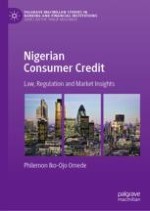2022 | OriginalPaper | Buchkapitel
6. A Synopsis of Consumer Lending Patterns in Formal Financial Institutions and Lenders’ Responses to Regulatory Reforms in Nigeria
verfasst von : Philemon Iko-Ojo Omede
Erschienen in: Nigerian Consumer Credit
Aktivieren Sie unsere intelligente Suche, um passende Fachinhalte oder Patente zu finden.
Wählen Sie Textabschnitte aus um mit Künstlicher Intelligenz passenden Patente zu finden. powered by
Markieren Sie Textabschnitte, um KI-gestützt weitere passende Inhalte zu finden. powered by
